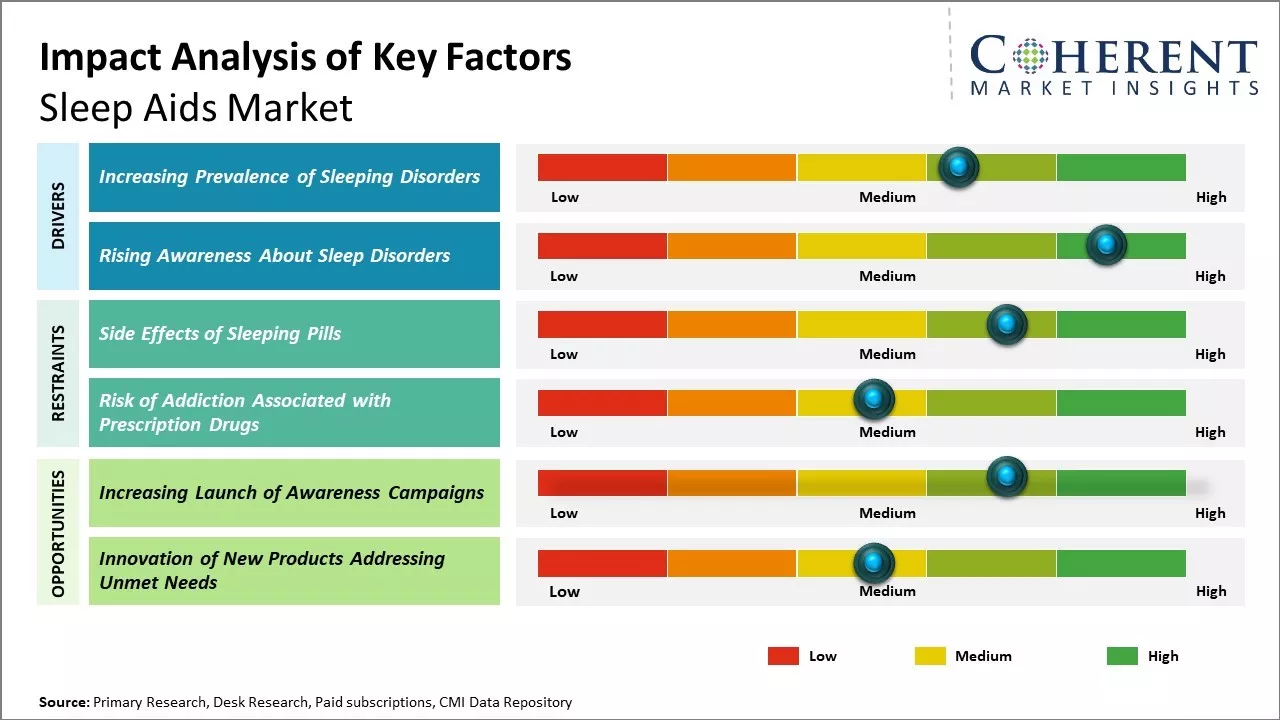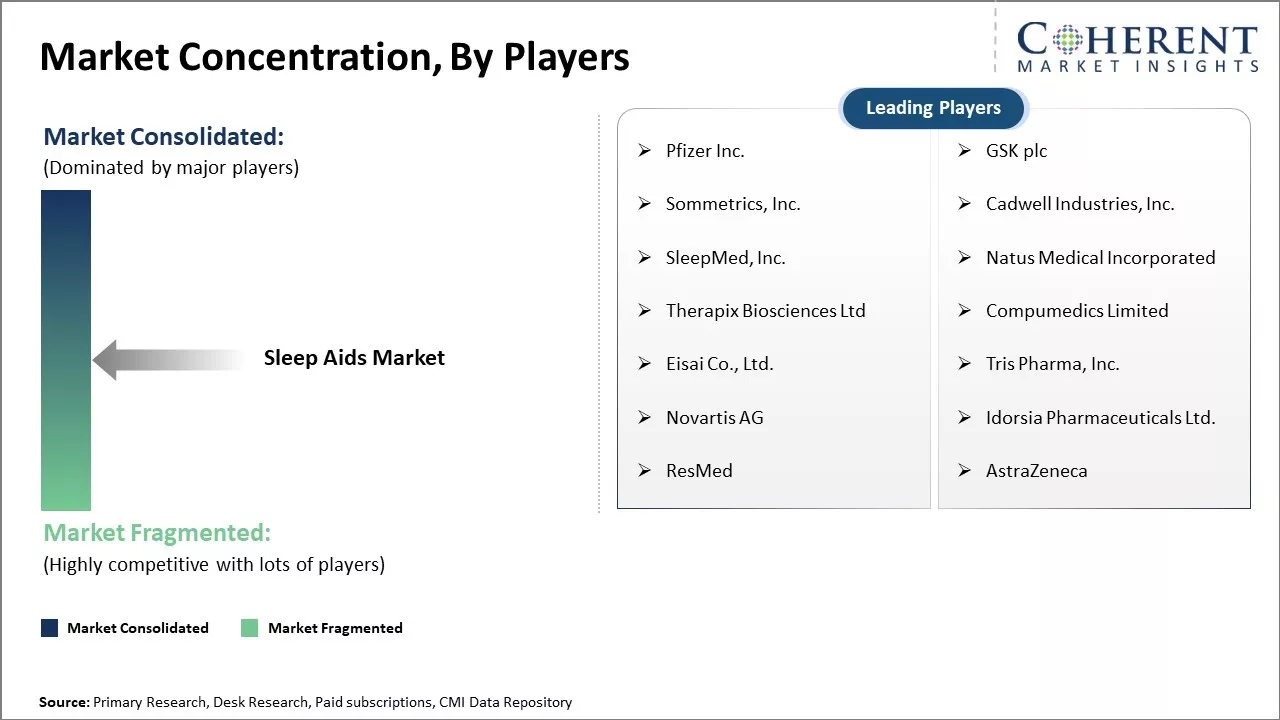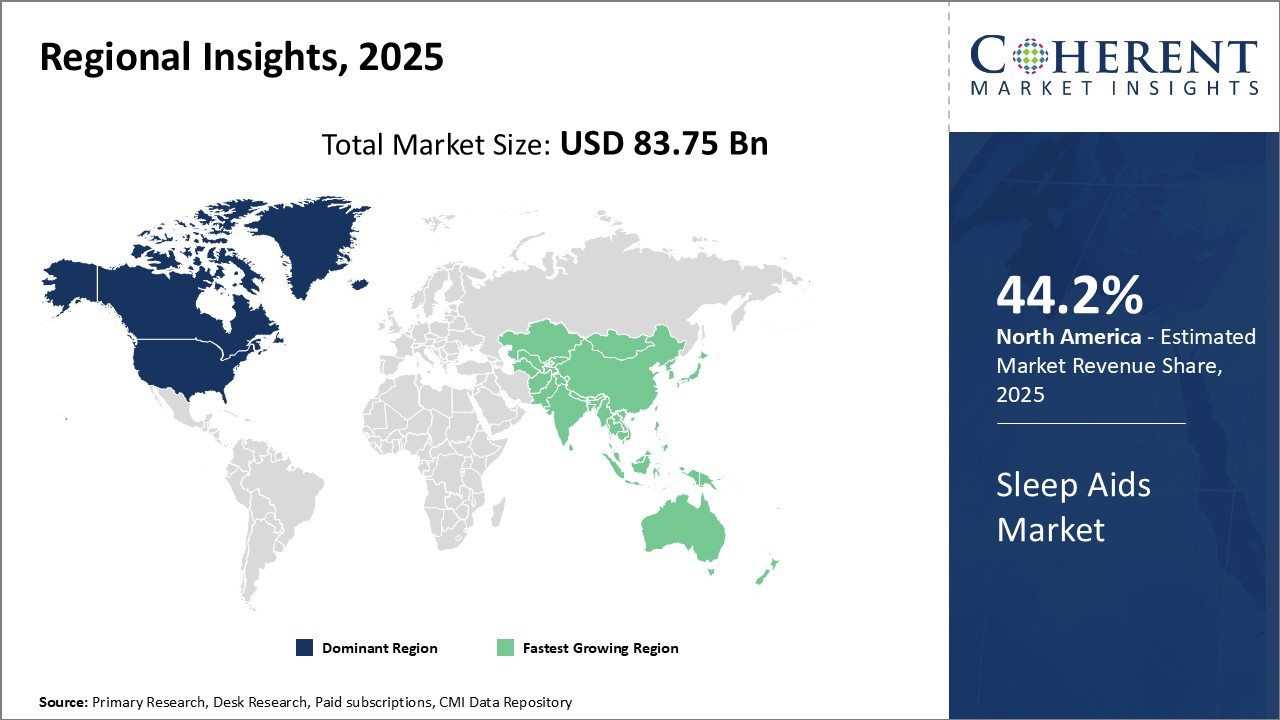The global sleep aids market is estimated to be valued at USD 83.75 Bn in 2025 and is expected to reach USD 141.77 Bn by 2032, exhibiting a compound annual growth rate (CAGR) of 7.8% from 2025 to 2032.

To learn more about this report, Download Free Sample
The market is experiencing strong growth due to increasing prevalence of sleep disorders (insomnia, sleep apnea) linked to hectic lifestyles, stress, and poor sleep hygiene. Moreover, advancements in medical devices (e.g., CPAP machines, wearables, sleep apps) are expanding non-pharmacological treatment options. However, side effects and dependency risk from prescription drugs, high costs of advanced devices, and stringent regulatory barriers are expected to hamper the global sleep‑aids market growth.
|
Event |
Description and Impact |
|
Regulatory Crackdowns on Prescription Sleep Medications |
|
|
Technological Revolution in Sleep Health |
|
Uncover macros and micros vetted on 75+ parameters: Get instant access to report

To learn more about this report, Download Free Sample
The product type, medications sub-segment is estimated to hold 52.9% of the market share in 2025 owing to their widespread availability and them being prescribed by doctors for sleep disorders. Sleeping pills are commonly prescribed for the short-term treatment of insomnia and other sleep issues.
The easy accessibility of over-the-counter sleep medications and their effectiveness in inducing sleep drives their high demand. Various prescription sleep drugs targeting different stages of sleep are available in the market. Popular ones include zolpidem, eszopiclone, zaleplon, etc. that act on the GABA receptors in the brain to calm the nervous system.
The well-established distribution channels of pharmaceutical companies ensure medicines reach consumers easily. While certain natural supplements are also emerging, they are yet to gain similar medical endorsement for sleep problems. Overall, the doctor's role in suggesting sleeping pills and proven results continue augmenting the medications segment.
The sleep apnea sub-segment is estimated to hold 37.9% of the market share in 2025 due to the high prevalence of insomnia. Insomnia is one of the most common sleep disorders affecting people of all ages.
As per studies, nearly 30% of adults experience insomnia occasionally, while 10% have chronic insomnia. The disorder involves difficulty falling asleep, frequent awakenings, early rising or non-restorative sleep. Its impact on daytime functioning and quality of life has raised awareness. Both short and long-term insomnia can be caused by stress, anxiety, depression, medical issues, lifestyle factors, etc.
Considering it does not require significant medical diagnosis, the overall awareness about insomnia as a sleep problem is higher compared to other disorders. This brings more people seeking treatment options for it. Consequently, the large insomnia patient pool looking for solutions ensures its primacy in the sleep aids market price.

To learn more about this report, Download Free Sample
North America remains the dominant region in the global sleep aids market companies and is estimated to hold 44.2% of the market share in 2025. The U.S. accounts for the bulk of the market owing to the high consumer awareness about various sleep disorders like insomnia.
According to The National Academy of Medicine, nearly 50-70 million American adults suffer from chronic sleep and wakefulness disorders annually. This has boosted the demand for over-the-counter as well as prescription sleep aids across various distribution channels in the region. The easy availability and wide acceptance of prescription drugs for insomnia plays a crucial role in consolidating North America's leadership position.
Asia Pacific has emerged as the fastest growing regional market driven by economic development and rising consumer incomes of markets like China, India, and Indonesia. Large untapped opportunities prevail in these emerging countries owing to changing lifestyles, increasing urbanization, rising stress levels, and growing health issues.
The growing middle class affords greater affordability and access to healthcare and wellness products. This has augmented the demand for sleep aids in Asia Pacific. While the market currently remains concentrated on traditional herbal medicines and supplements, the growing adoption of international products points to lucrative prospects. Export and manufacturing hubs in countries such as China and India bolster availability while positioning the region as an attractive investment destination.
The U.S. is considered as a leading country in the global sleep aids market during the forecast period. This dominance in attributed by high prevalence of sleep-related issues such as insomnia, restless leg syndrome, and sleep apnea. Additionally, strong pharmaceutical and wellness industries, widespread access to over-the-counter and prescription sleep medications, and consumer receptivity to both medical and alternative therapies fuels market growth.
Japan is considered as another player in the sleep aid market; it reflects the countries aging population and work-centric culture that resulted in sleep deprivation. The Japanese market is particularly active in non-pharmaceutical sleep aids, such as sleep-promoting mattresses, relaxation beverages, and innovative tech-driven solutions.
| Report Coverage | Details | ||
|---|---|---|---|
| Base Year: | 2024 | Market Size in 2025: | USD 83.75 Bn |
| Historical Data for: | 2020 To 2024 | Forecast Period: | 2025 To 2032 |
| Forecast Period 2025 to 2032 CAGR: | 7.8% | 2032 Value Projection: | USD 141.77 Bn |
| Geographies covered: |
|
||
| Segments covered: |
|
||
| Companies covered: |
Pfizer Inc., GSK plc, Sommetrics, Inc., Cadwell Industries, Inc., SleepMed, Inc., Natus Medical Incorporated, Therapix Biosciences Ltd, Compumedics Limited, Eisai Co., Ltd., Tris Pharma, Inc., Novartis AG, Idorsia Pharmaceuticals Ltd., ResMed, and AstraZeneca |
||
| Growth Drivers: |
|
||
| Restraints & Challenges: |
|
||
Uncover macros and micros vetted on 75+ parameters: Get instant access to report
Factors such as hectic lifestyles, erratic work schedules, and increasing stress levels have greatly impacted people's sleep cycles. Many users have increasingly relied on sleep aids to help them sleep better at night. Advancements in medical technology have also helped introduce new products and solutions in the market. Sleep aids devices and apps that use calming noises or guided meditation are becoming increasingly popular for treating occasional insomnia. However, traditional medications like sleeping pills continue to dominate the market. Looking ahead, the widespread adoption of digital-first solutions and the entry of newer startups in this space are expected to further drive innovative growth in the global sleep aids market value.
The increasing prevalence of sleeping disorders, such as insomnia and sleep apnea, is expected to propel the growth of the global sleep aids market outlook during the forecast period.
Another important growth driver for sleep aids market trends has been increasing awareness about sleep disorders and available treatment options. While sleep problems were previously considered more of a lifestyle issue, they are now recognized as serious medical conditions that require clinical interventions.
This has promoted greater acceptance of sleeping pills and other medications to induce normal sleep under doctor's supervision. Better education regarding sleep hygiene, benefits of sound slumber, and availability of prescribed relief has motivated individuals to seek timely help and treatment.
For instance, in February 2023, the American Academy of Sleep Medicine, launched the national “More than a Snore” campaign to raise awareness about obstructive sleep apnea, a chronic disease that involves the repeated collapse of the upper airway during sleep. This campaign raised awareness about obstructive sleep apnea and encourage undiagnosed patients to advocate for themselves and seek treatment.
Share
Share
About Author
Manisha Vibhute is a consultant with over 5 years of experience in market research and consulting. With a strong understanding of market dynamics, Manisha assists clients in developing effective market access strategies. She helps medical device companies navigate pricing, reimbursement, and regulatory pathways to ensure successful product launches.
Missing comfort of reading report in your local language? Find your preferred language :
Transform your Strategy with Exclusive Trending Reports :
Frequently Asked Questions
Joining thousands of companies around the world committed to making the Excellent Business Solutions.
View All Our Clients